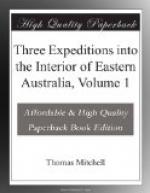(Footnote. Calostemma candidum, Lindley manuscripts; foliis...tubo perianthii limbo multo breviore, corona truncata dentibus sterilibus nullis, umbellis densis, pedicellis articulatis exterioribus multo longioribus.)
ROCKS OF BULLABALAKIT.
The hill immediately over our camp was Bullabalakit, and consisted partly of granular felspar, probably tinged greenish with chlorite; and partly of concretionary porphyry, the concretions being mottled red and white, and containing grains of quartz and crystals of common felspar; the white concretions resisting the action of the atmosphere stood in relief on the weather surface; I noticed also a vein of amethystine quartz.
December 24 and 25.
Ribs and thwarts were necessary to distend the canvas boats, and though we had brought only moulds of each sort, yet we had tools and hands to make them when required. We also sawed the pine wood into thin planks to form a floor in each boat, whereon to lay our stores. We made the ribs of bluegum (eucalyptus). The weather was excessively hot, yet the men worked hard at the saw-pit notwithstanding; but all our activity was in danger of being fruitless, for the river each day fell about four inches!
BOAT LAUNCHED.
December 26.
At half-past one P.M. the first boat was launched on the Namoi, and the keel of the second immediately laid down. The delay occasioned by the preparation of these boats was more irksome as the waters of the river continued to subside.
Amongst the objects, which in this country were quite new to me, were the insects continually buzzing about my tent. Of these, a fly as large as a small bee, and of a rich green and gold colour, being a species of stilbum, occasionally surprised me with a hum almost as musical as the tones of an Eolian harp.
BEES LOAD MY RIFLE WITH HONEY.
But the habits of the bees were very remarkable, judging from a singular circumstance which occurred respecting my rifle, for I found that a quantity of wax and honey had been deposited in the barrel, and also in the hollow part of the ramrod. I had previously observed one of these bees occasionally enter the barrel of the piece, and it now appeared that wax and honey had been lodged immediately above the charge, to the depth of about two inches. The honey was first perceived in the hollow part of the ramrod; and although an empty, double-barreled gun lay beside the rifle, neither wax nor honey was found in either of its tubes. The bee, which I frequently observed about my tent, was as large as the English bee, and had a sting.
December 28.
This day I sent off one of the men (Stephen Bombelli) with a despatch for the government at Sydney, giving an account of our journey thus far, and stating my intention of descending the Namoi in the boats. Bombelli was mounted on horseback, armed with a pistol, and provided with food for twelve days, being sufficient to enable him to carry the despatch to Pewen Bewen, and to return to the depot which I had arranged to establish here.




